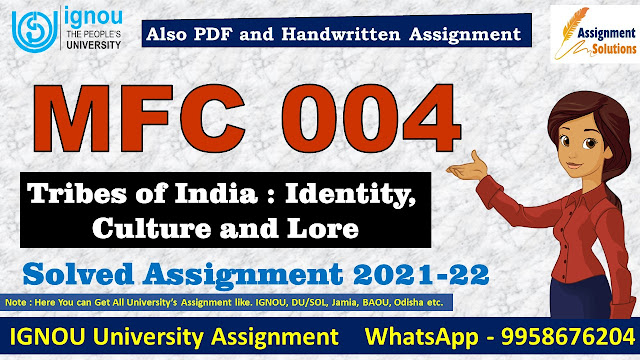MFC 004 Solved Assignment 2021-22
MFC-004
Tribes of India : Identity, Culture and Lore
Course Code : MFC-004
Course Title : Tribes
of India : Identity, Culture and Lore
Assignment Code :
MFC-004/TMA-01/2021-22
Coverage : All Blocks
MFC
004 Solved Assignment 2020-21 : All assignments are in PDF format which
would be send on email/WhatsApp (9958676204)
just after payment…
Attempt all questions. All questions
carry equal marks.
1. Attempt a critical note on seasonal migration as a strategy
of survival for the hunting-gathering tribes of India.
A hunter-gatherer is
a human living a lifestyle in which most or
all food is obtained by foraging (gathering edible
wild plants) and hunting (pursuing and killing of wild
animals), like what most natural omnivores do. Hunter-gatherer societies stand
in contrast to the more sedentary agricultural societies, which rely
mainly on cultivating crops and raising domesticated
animals for food production, although the boundaries between the two ways
of living are not completely distinct.
Hunting and gathering was
humanity's original and most enduring
successful competitive adaptation in the natural world,
occupying at least 90 percent of human history. Following
the invention of agriculture, hunter-gatherers who did not change were
displaced or conquered by farming or pastoralist groups in most parts
of the world. However, the division between the two is no longer presumed
to be a fundamental marker in human history, and there is not necessarily a
hierarchy which places agriculture and industry at the top as a goal to be
reached.
Only a few contemporary societies
are classified as hunter-gatherers, and many supplement their foraging activity
with horticulture or pastoralism. Contrary to common
misconception, hunter-gatherers are mostly well-fed rather than starving, and
tend to have a more diverse and arguably more healthy diet.
Hunting and gathering was
presumably the subsistence strategy employed by human societies
beginning some 1.8 million years ago, by Homo erectus, and from its
appearance some 200,000 years ago by Homo sapiens. Prehistoric
hunter-gatherers lived in groups that consisted of several families resulting
in a size of a few dozen people. It remained the only mode of subsistence
until the end of the Mesolithic period some 10,000 years ago, and
after this was replaced only gradually with the spread of the Neolithic
Revolution.
During the 1970s, Lewis
Binford suggested that early humans obtained food
via scavenging, not hunting. Early humans in the Lower
Paleolithic lived in forests and woodlands, which allowed
them to collect seafood, eggs, nuts, and fruits besides scavenging. Rather than
killing large animals for meat, according to this view, they used carcasses of
such animals that had either been killed by predators or that had
died of natural causes. Archaeological and genetic data suggest that the
source populations of Paleolithic hunter-gatherers survived in
sparsely wooded areas and dispersed through areas of high primary productivity
while avoiding dense forest cover.
According to the endurance
running hypothesis, long-distance running as in persistence hunting, a
method still practiced by some hunter-gatherer groups in modern times, was
likely the driving evolutionary force leading to the evolution of certain human
characteristics. This hypothesis does not necessarily contradict the scavenging
hypothesis: both subsistence strategies could have been in use sequentially,
alternating or even simultaneously.
Starting at the transition between
the Middle to Upper Paleolithic period, some 80,000 to
70,000 years ago, some hunter-gatherer bands began to specialize, concentrating
on hunting a smaller selection of (often larger) game and gathering a smaller
selection of food. This specialization of work also involved creating
specialized tools such as fishing nets, hooks, and
bone harpoons. The transition into the
subsequent Neolithic period is chiefly defined by the unprecedented
development of nascent agricultural practices. Agriculture originated
as early as 12,000 years ago in the Middle East, and also independently
originated in many other areas including Southeast Asia, parts
of Africa, Mesoamerica, and the Andes.
2. What are the social structures and gender stereotypes that
the tribes of India use for asserting their identity?
3. What are the political processes of the Indian constitution
that define the relation between tribe, politics and development.
4. Distinguish the following:
(A) Migrant laborers and tribal laborers
(B) Groups and sub-groups of Indian tribes
(C) Etiological tales and written traditions.
(D) Hunting and Gathering tribes and Nomadic tribes.
MFC 004 Solved Assignment 2020-21 : All assignments are in PDF format which would be send on email/WhatsApp (9958676204) just after payment…
5. Write short notes on the following:
(A) Mongoloids
(B) Paraja tribe
(C) Tribes and the ‘others’
(D) Mendicant nomads of West Bengal
For PDF And HandWritten
Whatsapp 9958676204


Post a Comment